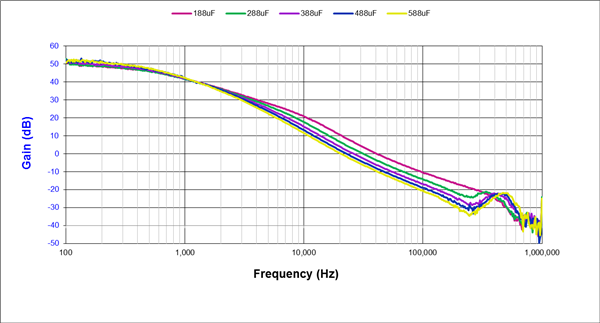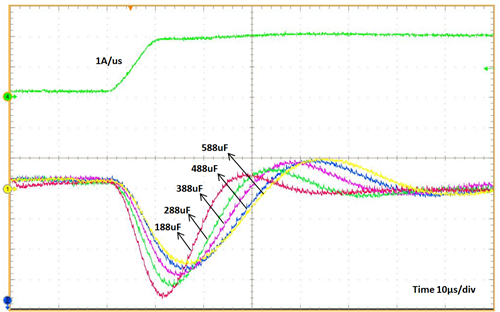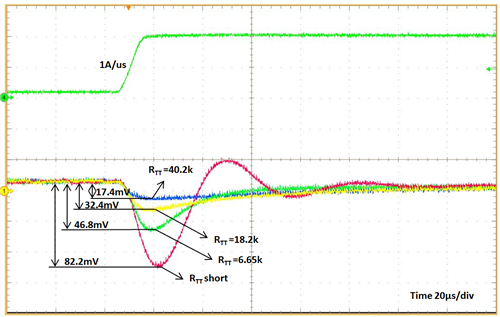SSZT818 January 2018 TPSM84424 , TPSM84624 , TPSM84824
Ever-evolving technology demands smaller, modular, performance-driven solutions. Power modules contribute to small solution sizes and board-space requirements, but can reduce design flexibility. While power modules reduce solution sizes, there's been an additional push to improve transient response. Many newer DC/DC regulators and power modules internalize loop compensation or feature operating architectures that do not require loop compensation, making them very easy to use. But in some cases, that could reduce your ability to fine-tune design performance.
Solving the Problem of Fast Transient Response with Accuracy
| Symbol | Min | Typ | Max | Units |
|---|---|---|---|---|
| FPGA logic | ||||
| VCCINT | 0.97 | 1.00 | 1.03 | V |
| 0.87 | 0.90 | 0.93 | V | |
| VCCBRAM | 0.97 | 1.00 | 1.03 | V |
| 0.87 | 0.90 | 1.03 | V | |
While small capacitance increments are allowable, larger amounts could negatively affect the module’s load transient response. To optimize transient response, designers typically add a feedforward capacitor (CFF) in parallel with the upper feedback resistor, as shown in Figure 1. In the frequency domain the addition of CFF creates a zero, which increases bandwidth and improves the transient response time.
 Figure 1 Feedback Divider with
Feedforward Capacitor CFF
Figure 1 Feedback Divider with
Feedforward Capacitor CFFUnfortunately, this solution isn't perfect either; while CFF creates a zero to help increase bandwidth, it also creates a subsequent pole as a product of CFF and the parallel combination of feedback resistors. This pole can negate the benefits brought about by the zero of the CFF. Since CFF adds a zero and a pole, which may not be too far apart in frequency, the choice and calculation of CFF becomes tricky. The right CFF value will help the situation, while a wrong CFF value will bring no improvement and will just be a useless addition to the bill of materials (BOM).
How One Resistor Can Improve Performance
 Figure 2 Power Module with TurboTrans
Technology
Figure 2 Power Module with TurboTrans
TechnologyThe RTT resistor is nothing but an additional series resistor in the Type II compensation scheme. This additional RTT resistor doesn’t require in-depth knowledge of loop compensation techniques because, like for any other power module, the data sheet will provide an equation to calculate the right value. Your calculation will simply depend on the amount of total output capacitance. The RTT will compensate for any additional capacitance at the output, and the load transient response will remain spectacular.
TurboTrans in Action
 Figure 3 Gain Curve with Different
Output Capacitance
Figure 3 Gain Curve with Different
Output Capacitance Figure 4 Transient Response with
Different Output Capacitance
Figure 4 Transient Response with
Different Output Capacitance| Output capacitance (µF) | Crossover frequency (kHz) | Voltage droop (mV) |
|---|---|---|
| 188 | 41.0 | 114.6 |
| 288 | 31.3 | 103.2 |
| 388 | 26.0 | 92.4 |
| 488 | 22.8 | 86.4 |
| 588 | 20.5 | 82.2 |
The situation improves if you use the TurboTrans feature. By adjusting the TurboTrans resistor, you can easily get 17.4mV of voltage droop, as shown in Figure 5.
 Figure 5 Transient Response with
TurboTrans Technology
Figure 5 Transient Response with
TurboTrans TechnologyConclusion
Additional Resources
- Learn more about TI DC/DC power modules.
- Read the application report, “LMZ1050x/LMZ1050xEXT SIMPLE SWITCHER® Power Module – Quick Compensation Design.”